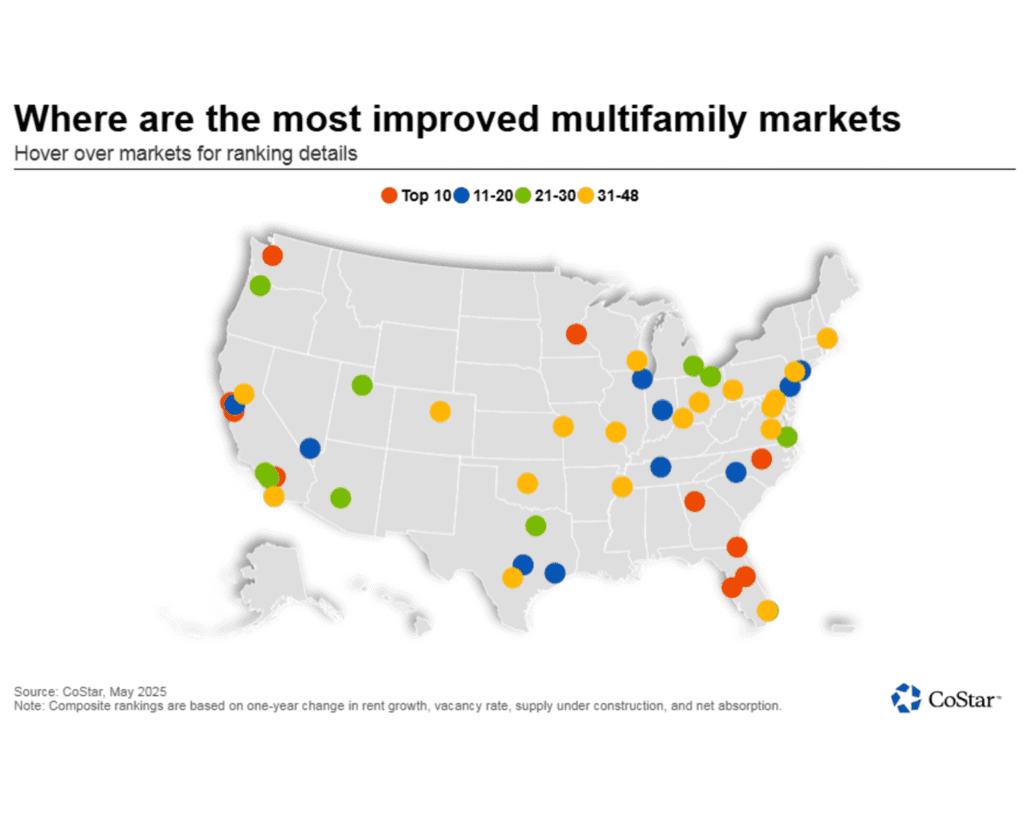|
Getting your Trinity Audio player ready...
|
The 2025 U.S. Apartment Market Rebound: What’s Fueling the Recovery
The U.S. apartment market rebound in 2025 is more regionalized than ever. While housing affordability remains a national issue, rental demand is growing in specific metros, fueled by job growth, migration, and shifting renter preferences. Florida, the West Coast, and the Midwest are emerging as clear leaders—each for very different reasons.
See how these trends began in our 2024 housing analysis and what’s different now.
Florida’s Apartment Market Rebound: Growth Fueled by Migration
The Florida apartment market rebound is one of the clearest signs of the broader U.S. recovery. Jacksonville, Tampa, and Orlando have experienced double-digit demand increases, driven by a combination of job creation and population growth. According to CoStar, these cities top the national momentum rankings for multifamily performance.
Jacksonville’s population grew by 9% between 2020 and 2024. Tampa’s rent growth outperformed national averages even as thousands of new units entered the market. These trends reflect a broader shift toward affordability and lifestyle-driven relocation across the Southeast.
Need more context? Visit our Florida rental market tracker.
Tech-Driven Rebound on the West Coast Rental Market
The West Coast apartment rebound in 2025 is gaining speed. San Francisco, San Jose, and Seattle are reversing prior declines thanks to renewed tech hiring and a return to urban living. San Francisco’s rent growth ranks first nationally, while San Jose has seen the strongest leasing uptick in over five years.
According to CBRE, AI and biotech firms are expanding in California, leasing office space and drawing talent back downtown. In Seattle, a constrained development pipeline has preserved rent gains, despite slow initial recovery post-COVID.
Explore more in our West Coast multifamily market review.
Midwest Rental Markets Join the U.S. Apartment Market Rebound
The Midwest apartment market rebound is a quiet but powerful trend in 2025. Chicago and Minneapolis are outperforming expectations with high occupancy and controlled rent increases. Chicago ranks top 10 for both rent growth and vacancy tightening, proving its ability to digest new supply.
Minneapolis continues to benefit from a favorable rent-to-income ratio, which has helped maintain strong affordability and high demand. The city’s restrained new construction approach is supporting a landlord-friendly environment while keeping renters’ costs stable.
Want more regional analysis? Check out our Midwest housing outlook.
Corporate Relocations & Supply Decline Shape the 2025 Multifamily Market
A major driver of the U.S. apartment market rebound is corporate relocation. Atlanta, Raleigh, and Charlotte are among cities attracting Fortune 500 headquarters, increasing rental demand and strengthening absorption.
Simultaneously, multifamily construction has slowed sharply. The National Multifamily Housing Council forecasts a 48% drop in new completions in 2025. This tightening supply will likely stabilize or boost rent prices as demand continues to outpace deliveries.
Related: Why corporate moves are transforming rental markets.
Final Thoughts on the U.S. Apartment Market Rebound
The U.S. apartment market rebound is multifaceted. Florida shows how population growth fuels demand. The West Coast demonstrates tech’s power to reenergize housing. And the Midwest proves affordability remains a major competitive edge. As corporate relocations and supply slowdowns shape what’s next, watching these regional patterns is essential for investors and renters alike.

